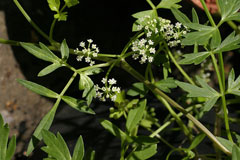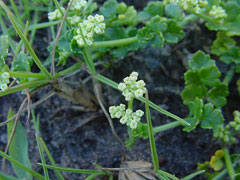 |
|
http://flickr.com/photos/8108294@N05 |
 |
| http://www.flickr.com/people/43206694@N03 |
Translate this page:
Summary
Physical Characteristics

 Apium prostratum is a PERENNIAL growing to 0.6 m (2ft). The species is hermaphrodite (has both male and female organs) and is pollinated by Flies. The plant is self-fertile.
Apium prostratum is a PERENNIAL growing to 0.6 m (2ft). The species is hermaphrodite (has both male and female organs) and is pollinated by Flies. The plant is self-fertile.
Suitable for: light (sandy), medium (loamy) and heavy (clay) soils. Suitable pH: mildly acid, neutral and basic (mildly alkaline) soils and can grow in saline soils.
It can grow in semi-shade (light woodland). It prefers moist soil.
UK Hardiness Map
US Hardiness Map
Synonyms
Plant Habitats
Cultivated Beds;
Edible Uses
Edible Parts: Leaves Root Seed
Edible Uses:
Leaves - a salty taste, it is used as a flavouring in soups etc or as a garnish in a similar way to parsley[193]. The leaves can also be eaten raw but have a very strong flavour[193]. The stems can be blanched and used like celery[154], but they are small and fibrous so are not very worthwhile[193]. Root. No further details. Seed - used as a flavouring in soups etc.
References More on Edible Uses
Medicinal Uses
Plants For A Future can not take any responsibility for any adverse effects from the use of plants. Always seek advice from a professional before using a plant medicinally.
None known
References More on Medicinal Uses
The Bookshop: Edible Plant Books
Our Latest books on Perennial Plants For Food Forests and Permaculture Gardens in paperback or digital formats.

Edible Tropical Plants
Food Forest Plants for Hotter Conditions: 250+ Plants For Tropical Food Forests & Permaculture Gardens.
More

Edible Temperate Plants
Plants for Your Food Forest: 500 Plants for Temperate Food Forests & Permaculture Gardens.
More

More Books
PFAF have eight books available in paperback and digital formats. Browse the shop for more information.
Shop Now
Other Uses
References More on Other Uses
Cultivation details
Prefers a rich moist soil with some shade in summer. The crushed leaves smell strongly of celery[193]. This plant used to be known as A. australe, along with a New Zealand form and a S. American form. Most botanists now only apply that name to the S. American form, the New Zealand form has been moved to A. filiforme (syn A, prostratum filiforme) whilst this Australian form is now known as A. prostratum[44, 193]. This plant has been suggested as having the potential to be bred as a cultivated vegetable[193].
References Carbon Farming Information and Carbon Sequestration Information
Temperature Converter
Type a value in the Celsius field to convert the value to Fahrenheit:
Fahrenheit:
The PFAF Bookshop
Plants For A Future have a number of books available in paperback and digital form. Book titles include Edible Plants, Edible Perennials, Edible Trees,Edible Shrubs, Woodland Gardening, and Temperate Food Forest Plants. Our new book is Food Forest Plants For Hotter Conditions (Tropical and Sub-Tropical).
Shop Now
Plant Propagation
Seed - sow spring in a greenhouse. Germination can be a bit slow, taking a month or more. When large enough to handle, prick the seedlings out into individual pots and plant them out in the summer. Division in spring.
Other Names
If available other names are mentioned here
Native Range
SOUTHERN AMERICA: Brazil (Paraná, Rio Grande do Sul, Santa Catarina), Argentina (Mendoza, Buenos Aires, Chubut, Santa Cruz, Tierra del Fuego), Chile, Uruguay AUSTRALASIA: Australia (Tasmania, New South Wales, Queensland, South Australia, Victoria, Western Australia), New Zealand
Weed Potential
Right plant wrong place. We are currently updating this section.
Please note that a plant may be invasive in one area but may not in your area so it's worth checking.
Conservation Status
IUCN Red List of Threatened Plants Status :

Growth: S = slow M = medium F = fast. Soil: L = light (sandy) M = medium H = heavy (clay). pH: A = acid N = neutral B = basic (alkaline). Shade: F = full shade S = semi-shade N = no shade. Moisture: D = dry M = Moist We = wet Wa = water.
Now available:
Food Forest Plants for Mediterranean Conditions
350+ Perennial Plants For Mediterranean and Drier Food Forests and Permaculture Gardens.
[Paperback and eBook]
This is the third in Plants For A Future's series of plant guides for food forests tailored to
specific climate zones. Following volumes on temperate and tropical ecosystems, this book focuses
on species suited to Mediterranean conditions—regions with hot, dry summers and cool, wet winters,
often facing the added challenge of climate change.
Read More
Expert comment
Author
Labill.
Botanical References
265
Links / References
For a list of references used on this page please go here
Readers comment
| Add a comment |
|
If you have important information about this plant that may help other users please add a comment or link below. Only comments or links that are felt to be directly relevant to a plant will be included. If you think a comment/link or information contained on this page is inaccurate or misleading we would welcome your feedback at [email protected]. If you have questions about a plant please use the Forum on this website as we do not have the resources to answer questions ourselves.
* Please note: the comments by website users are not necessarily those held by PFAF and may give misleading or inaccurate information.
To leave a comment please Register or login here All comments need to be approved so will not appear immediately.
|
Subject : Apium prostratum
|
|
|
|